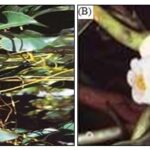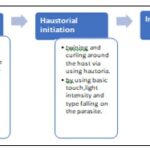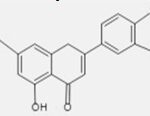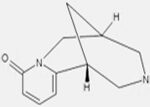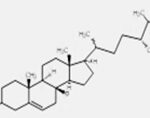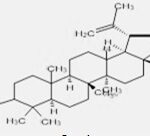CUSCUTA REFLEXA ROXB.: A PHARMACOLOGICALLY MERITORIOUS HOLOPARASITIC PLANT
HTML Full TextCUSCUTA REFLEXA ROXB.: A PHARMACOLOGICALLY MERITORIOUS HOLOPARASITIC PLANT
Aman Guleria *, Upasana Thakur, Arti Devi, Amardeep Ankalgi, Vinay Pandit and Mahendra Ashawat
Department of Pharmaceutical Analysis and Quality Assurance, Laureate Institute of Pharmacy, Kathog, Himachal Pradesh, India.
ABSTRACT: Natural sources like minerals, plants, and animals were used for various diseases by the human civilization from their very initials and were called traditional medicines. The traditional system of medicine is the backbone of a new class of drugs: phytomedicine or phytopharmaceuticals. These drugs are economically very important shortly in the pharmaceutical industry. The Cuscuta reflexa as phytomedicine brings us many medicinal importance in many diseases. Phytomedicines are employed to the population by analyzing its safety and efficacy. The Cuscuta reflexa Roxb. plant products are known for its diverse traditional uses in many diseases. C. reflexa has many medicinal properties for effective management such as antioxidant, anti-ulcer, antispasmodic, effective in jaundice and many more. Here, we use to review for the Phytochemical investigation and pharmacological effects of the Cuscuta reflexa Roxb. This review will try to enlighten the very specific and predictable use of this plant following the ailment in the body as a remedy.
Keywords: Cuscuta reflexa Roxb, Phytochemicals, In-vitro studies, Pharmacological activities, Traditional use
INTRODUCTION: About 365 plants are reported to be useful as medication in ancient times. According to WHO, about 70% to 95% of the majority of developing countries still depend on traditional medicine as their remedy for various ailments. People use plants for their various therapeutical properties against inflammation, allergies, oxidation, microbial infection, diabetes, ageing, and more. The plant as a whole is not considered a standard medicine (like in the Ayurvedic system of medicine) for getting a nearby pharmacological effect for a particular disease; we must have to become aware of the phytoconstituents present in the plants.
By considering this, a new category of the drug came into existence called phytopharmaceutical. The phytopharmaceuticals is a balanced approach that trust everything but underlines the revalidation of the specification of the plant material or product. It is defined as a purified and standardized fraction with a defined minimum four bio-active or phytochemical compounds in the extract of a medicinal plant or its part for internal or external use by human beings or animals for diagnosis, treatment, mitigation or prevention of disease or disorder but the parenteral route of administration is discouraged by the scientists.
Phytomedicine brings new lead drug discoveries, and phytopharmaceuticals assure the people of its safe and productive use of plant-based medicinal products. Plant sources act as a new lead compound provider due to the various chemical entities present in them 1. The plants produce Secondary metabolites, of which a total of 15000 have been isolated, which is less than 10% of the total secondary metabolites produced by plants. These secondary metabolites act as plant’s defence mechanism against various microorganisms, insects, herbivores and also effective for animals against various diseases or disorders.
Cuscuta reflexa Roxb: It is a plant used to live on other plants by climbing and curling around them like wine and sucking the necessary nutrients from the host plant via attaching a special organ called haustoria to the host. It is a parasitic plant. It is categorized as an Angiospermic plant. It belongs to the morning glory family Convolvulaceae having genus Cuscuta and species reflexa. Cuscuta comprises 100- 170 species that comes under the class Eudicots. Cuscuta is found in the temperate and mainly in tropical regions of the world, with huge species diversity in tropical and subtropical regions 2. It is known to parasitize the majority of angiosperms.
Some traditional classifications placed Cuscuta in its own family, Cuscutaceae, but always allied with Convolvulaceae. With the advancement in the field of science, it is found in the molecular phylogenetic study that Cuscuta species have APG (Angiosperm Phylogeny Group) classifications which resemble the genus Ipomoea L. Data from nuclear, mitochondrial, and plastid genomes were used to show that Cuscuta was nested within Convolvulaceae. Still, despite extensive analysis, its exact position in the family could not be determined. Subsequent molecular phylogenetic work has provided a robust framework for the species within the genus. In English, it is known as Dodder. It is also known as Amarbel (Immortal twine), Akashwell (Sky winner), Swarnlata, Akakhilata. Other names include Hell weed, Devils gut, Begger weed, Scald weed, Dodder of thyme, Greater dodder Lesser dodder 3.
TABLE 1: BOTANICAL CLASSIFICATION 4
| Taxonomical classification | |
| Kingdom | Plantae |
| Subkingdom | Tracheobionta |
| Super division | Spermatophyta |
| Division | Angiosperms |
| Class | Eudicots |
| Subclass | Asterids |
| Order | Solanales |
| Family | Convolvulaceae |
| Genus | Cuscuta |
| Species | reflexa Roxb. |
TABLE 2: VERNACULAR NAMES
| Vernacular names | |
| English | Dodder Plant |
| Hindi | Amarabela |
| Sanskrit | Akasavalli, Amaravalli, Khavalli |
| Punjabi | Zarbut |
| Urdu | Akashbel |
| Bengali | Akashbel |
Morphological Characteristics:
Stem: It contains all the major plant parts. The stem is highly branched and vegetative during favourable conditions. It is a weak, twiner, pale-green, that develop haustoria at the point of contact with the host plant.
The main organs of the stems are vascular bundles (xylem and phloem), and meristem. The main secondary metabolites are also present, like, terpenoids, carbohydrates, fats, etc.
Haustoria: It is a special organ developed as a result of the evolution of plants. It has two main stages based on its maturity in the host plant body. Further developed into haustoria hairs. These are hair-like projection that ultimately enters into the host body.
Flowers: The flowers are very distinct in shape and also small as compared to the other genus of Cuscuta species.
It has 5 petals and four lobes, Bracteate, ebracteolate, hermaphrodite, actinomorphic, pentamerous, small and pale-green. Further.
Gynoecium: Style very much reduced, disc red coloured, 2 carpels, syncarpous, superior, bilocular.
Carpels: Medially placed, 2 or more ovules in each locule, axile placentation stigma bifid and hairy, a nectareous disc is present below the ovary.
Androecium: 5 stamens, epipetalous, filaments of different sizes dorsifixed, alternipetalous.
Corolla: 5 petals, united, campanulate, valvate, with 5 coronary outgrowths at the base corolla.
Calyx: 5 sepals, fused, valvate.
Seed: These are small with hard coats which helps them survive many harsh seasons and climates. The seeds are viable for a very long period of time.
FIG. 1: C. REFLEXA STEM (A) AND FLOWER (B)
Initiation of Vegetative Parts of the Cuscuta Plant:
Initiation and Development of Sepals: Initiation starts with one lateral, adaxial sepal, either to the sides of the median plane. It is followed immediately by the second lateral, adaxial sepal. All the sepals are initiated abaxially. The two sepals grows faster than the remaining three sepals. Finally, calyx aestivation is quincuncial and at a length of about 3-4 mm the calyx is pressed open by the elongating corolla-filament tubes.
Initiation and Development of Petals: Petals are pentagonal and at the angles, five petal primordia are initiated more or less simultaneously and separate from each other development of the anthers then the gynoecium is closing and at last the petals begin to grow faster and bend over these organs. The five petals are connected by bridges of the developing filaments of the stamens and a long corolla filament tube is formed.
Initiation and Development of Stamen: The stamens grow along with the petals.
Initiation and Development of the Gynoecium: The gynoecium grows simultaneously with the stamens 5.
Geographical Distribution: Cuscuta reflexa Roxb. occurs throughout India. This species is common over the northern region of the country, Bengal plains, Western ghats, Satara region, Himachal Pradesh, Uttar Pradesh, and Uttarakhand. It is also found in the plain of Afghanistan, Malaysia, Nepal and Thailand 6. The Cuscuta reflexa mainly parasitizes all the angiospermic plants. The highly frequent host plants are given in the table below. The hosts include ephemeral, annual, biennial, and perennial life span; herb, shrub, climber, liana, and tree habits; and agricultural, horticultural, medicinal, weeds, forest, and economically important plants 7, 8, 9, 10, 11.
TABLE 3: FAVOURABLE AND HIGHLY FREQUENT HOSTS OF THE CUSCUTA PLANT
| Host plants/botanical names | Vernacular name |
| Justicia adhatoda (Acanthaceae) | Vasaka |
| Lannea coromandelica (Anacardiaceae) | Jiga |
| Mangifera indica (Anacardiaceae) | Aam |
| Calotropis gigantea (Apocynaceae) | Safed aak |
| Cascabela thevetia (Apocynaceae) | Karabi |
| Tabernaemontana divaricata (Apocynaceae) | Tagor |
| Alstonia scholaris (Apocynaceae) | Chhativan, satawana |
| Acacia nilotica (Fabaceae) | Babool |
| Datura metel (Solanaceae) | Dhatura |
| Bambusa tulda ( Poaceae) | Bans |
| Oryza sativa (Poaceae) | Paddy/Dhaan |
| Aegle marmelos (Rutaceae) | Bel |
| Lantana camara (Verbenaceae) | Raimuniya |
| Annona squamosa (Annonaceae) | sitaphal |
| Catharanthus roseus (Apocynaceae) | shisham |
| Duranta plumieri (Verbenaceae) | lal dudhi |
| Ficus glomerata (Moraceae) | udumbra, gular, rumbal |
| Jatropha curcas (Ephorbiaceae) | darvanti, jamal ghota |
| Linum usitatissimum (Linaceae) | Alsi, atashi |
| Medicago sativa (Fabaceae) | lahsun ghas, ashvabala |
| Nerium oleander (Apocynaceae) | Kaner or Ashvaghna, Karavira |
| Phyllanthus niruri (Euphorbiaceae) | Bhui aonla, Jaramla |
| Punica granatum (Mytraceae) | Pomegranate, anar |
| Ricinus Communis (Euphrobiaceae) | arandi |
| Solanum tuberosum (Solanaceae) | potato, aloo |
| Vitex negundo (Verbenaceae) | indrani, sambhalu |
| Acacia catechu (Mimosaceae) | Khair(katha) |
| Pyrus communis(Rosaceae) | Naspati |
| Cajanus cajan(Fabaceae) | Arhar |
| Lawsonia inermis (Apiacea) | Mehendi |
| Azadirachta indica(Meliaceae) | neem |
| Carissa spinarum(Apocynaceae) | Karonda |
| Ziziphus mauritiana(Rhamnaceae) | Ber / plum |
| Hibiscus rosa sinensis (Malvaceae) | rudrapushpa, babuitulsi |
| Impatiens species (Balsaminaceae) | dronapushpi, chhota halkusa |
FIG. 2: LIFE CYCLE OF CUSCUTA PLANT 12:
Scientific Research:
TABLE 4: IN-VITRO STUDIES RECORDED IN CUSCUTA REFLEXA PRESENT ON THE DIFFERENT HOSTS
| Host plant | Total flavonoid contents | Total phenolic content | DPPH scavenging activity |
| (Mg QE/g | (Mg GAL/g | (IC50 µ/ml)*** | |
| Extract)* | Extract)** | ||
| D. longan | 44.49±1.07c | 54.09±3.26b | 478.99±4.71c |
| S. asper | 76.88±2.18a | 70.25±1.41a | 231.38±2.81a |
| Z. dongnaiensis13 | 49.86±0.91b | 57.63±1.97b | 289.63±3.88b |
| A. indica | 82.91a a ± 0.71 | 66.30 b a ± 2.1(80% | 65.11a b ± 2.01(80% |
| 80% methanolic) | methanolic) | methanolic) | |
| Z. jojoba | 85.11a a ± 0.93 | 71.11a a ± 3.52 | 79.57a a ± 1.11 |
| M. alba | 72.03a b ± 0.69 | 61.01c a ± 2.18 | 44.29a d ± 1.02 |
| A. arabica | 73.28a b ± 1.29 | 51.29d a ± 2.01 | 51.03a c ± 1.02 |
| A. nilotica | 73.29a b ± 1.42 | 47.02e a ± 2.13 | 47.08a ± 1.52 |
| E. jambulana14 | 53.11a e ± 1.02 | 69.1 a ± 1.99 | 63.82a b ± 2.11 |
| Coccinia grandis | 114.4±0.7a | 90.8±2.9a | 168.7±1.0a |
| Ficus racemosa | 79.0±1.8b | 86.6±0.5b | 201.6±0.5b |
| Samanea saman15 | 67.5±2.6c | 84.4±1.4b | 279.7±6.0c |
Values are mean (n = 3) ± SD (standard deviation). *Values are expressed as quercetin equivalents in mg/g extract. **Values are expressed as gallic acid equivalent in mg/g extract. *** Values are expressed as DPPH scavenged by cuscuta sample extract in IC50 µ/ml.
Based on the characteristic, each type of Cuscuta sp. has a different phytochemical identity. Diverse types of phytocomponents have been isolated from the Cuscuta reflexa plant based on the host and plant nutrition 16. Most of the phytochemicals are listed below, reported so far in the plant Cuscuta reflexa. They were mainly alkaloid, flavonoids, phenols, glycosides, terpenoids, etc 17. The various chemical constituents are present in various extracts obtained from the plant and so the plant exhibits various pharmacological activities like antioxidant, antibacterial, antidiabetic, anticarcinogenic, antispasmodic, effective in jaundice, etc 18, 19.
TABLE 5: PHYTOCONSTITUENTS REPORTED IN CUSCUTA REFLEXA ROXB.
| Phytochemicals | Chemical Constituents | Structure |
| Flavonoids
|
Quercetin20, Hyperoside, Kaempferol, Myricetin, Quercetin 3-O- neohesperidoside21, Leuteolin, Quercetin-3-O-glucoside, 3,5,7,3’ -pentahydroxy flavanone (taxifolin Reflexin22, 5-hydroxy-7-methoxy-6- (2,3-epoxy-3- methylbutyl)-flavanone Kaempferol-3-O- glucoside23, Myricetin-3-O-alpha- rhamnoside Apigenin-7-b-rutinoside24 3’ -methoxy-3’,4’,5,7- tetrahydroxy flavone, 3’ -methoxy-4’,5,7- trihydroxy flavone-3- glucoside25, Myricetin-3- glucoside, 6,7,8- Trimethoxy 2H-1- benzopyran-2-one, 4,4’ ,6-Trihydroxyauran, Chlorogenic acid26, Azaleatin, Melanettin 3,4’ ,5,7-Tetrahydroxy flavanone, Taxifolin 7-O- b D- glucopyranoside27, | Quercetin
|
| Alkaloids
|
Methylcytisine26, Laceeroic acid Lupanine28, Sparteine, Cuscutamine Cytisine29
|
Cytisine |
| Glycosides
|
Cuscutin20 Cuscutoside-B, Arbutin, p-Coumaric acid Coumaric acid 4,5-dicaffeoylquinic acid 3,4-Di-O-caffeoylquinic acid4-oic acid-7-oxo-kaurene- 6 alpha-O- b D- glucoside26, Cuscutoside-A30, Caffiec acid31, 21-Hydroxy odoroside H Odoroside Cuscutin H32,
|
Cuscutin |
| Sreoids and sterols
|
Stigmast-5-en-3-O-b-D- glucopyranoside b Stigmast-5-en-3-yl- acetate23, Campesterol Sesamin26 Gitoxigenin32 Stigmasterol33 | Campesterol |
| Terpenoids and sesquiterpenes
|
Lupeol23, Oleanolic acetate Alpha – Amyrin Beta – Amyrin Alpha Amyrin Acetate Beta Amyrin Acetate Hydroxyoleanane Maragenin 26, Aromandendrin 27, Ursolic acid 32, | Lupeol |
| Carotenoids
|
Carotene21 Lutein Lycopene24, Violaxanthin Rubixanthin 26 | Lutein |
TABLE 6: TRADITIONAL USE OF CUSCUTA REFLEXA PLANT
| Plant Part | Type of dosage form | Tradition use |
| Used whole plant | Paste
|
Treatment of swollen testicles, gout and joint pain, causes abortion, anti-rheumatic, analgesic30-40, |
| Maceration | Infection treatment41 | |
| Infusion | Anti-poisonous42 | |
| Juice | Antiseptic, useful in itching skin and jaundice43,44 | |
| Pills | Anti-tuberculosis 46 | |
| Powder | Anti-fertility agent, astringent, diaphoretic 45 | |
| decoction | Useful in skin disease, jaundice, cough, bronchitis, fever, sex stimulation, anti-diarrheal, anti-inflammatory, anti-ulcer, anti-dandruff, fracture joining 44, 46-52 | |
| stem | Decoction | Hepatoprotective, anti-diarrheal, useful in constipation, stomach disorders, urinary tract infections, jaundice, epilepsy, cholera, asthma49, 53 |
| Paste | Anti-hair fall, anti-rheumatic, useful in skin diseases49,54 | |
| Juice | Jaundice treatment49,55 | |
| Crushed | Blood purifier, purgative, good for brain, fever, anthrax in cattle56,57 | |
| Seeds | Decoction
|
Cause abortion 49 Carminative, anthelmintic, sedative, diuretic, liver disorders useful in ulcer 58, 59, 60 |
| Leaves | Poultice | Pain reliever |
| Extract | Anti-hypertensive, anti-diarrheal, useful in jaundice61-63 | |
| Fruits | juice | Effective in scabies, eczem, Antipyretic, cough reliever 64 |
Pharmacological Activities of Cuscuta reflexa: When taken internally treats the retention of urine while being applied externally for skin itches. It is also used to cure cough and diabetes, eczema abortifacient, cholinergic action, anti-steroidogenic activity, hepatoprotective activity, diuretic activity, anticonvulsant activity.
Hepatoprotective Activity: A Hydro- alcoholic extract of C. reflexa has hepato- protector activity in albino rats against paracetamol-induced hepatic damage and acts as a hepatoprotective agent 2. The methanolic extracts of C. reflexa is evaluated for hepatoprotective activity on carbon tetrachloride-induced hepatotoxicity in liver histoarchitecture and alteration in certain biological parameters was observed 65.
Antitumor Activity: The Chloroform and ethanol extracts have antitumor activity reported against Ehrlich ascites carcinoma tumour in mice at doses of 200 & 400 mg/kg body weight orally 66, 67.
Antioxidant Activity: The antioxidant capacity was measured using various assays like reducing power, DPPH scavenging activity, and percent inhibition of linoleic acid peroxidation. Various extracts from treating the plant with various solvents were analyzed for the quantity of phenols and flavonoids 18. The Ethyl acetate and ethanol extract of the plant showed higher activity than other fractions, very close and identical in magnitude and comparable to the standard antioxidant agents 68.
Antibacterial Activity: An ethanolic extract of Cuscuta reflexa showed antimicrobial activity against E. coli and S. sonnei. Plants collected from different seasons showed antimicrobial activity against microorganisms like Staphylococcus epidermidis, Staphylococcus aureus, E. coli, Micrococcus luteus, Pseudomonas aeruginosa 69.
Antiepileptic and Anticonvulsive Activities: The significant reduction in the duration of convulsion in tonic seizure induced by pentylenetetrazol (30mg/kg Ip) in mice. The plant product reduces the convulsion induced by maximum electroshock against the tonic extension convulsion 2.
Hypoglycaemic Activity: A Methanolic extract showed significant inhibition against α-Glucosidase 70, 71.
Anti-HIV Activity: Water extracts of C. reflexa exhibited anti-HIV activity 72.
Effect on Blood Pressure: Alcoholic extract of Cuscuta reflexa has positive inotropic and cardiotonic activities on the perfuse frog heart. A Series of experiments on dogs results in a fall in blood pressure.
Cholinergic Action: The effects of the extract of C. reflexa resembled with that of an acetylcholine when tested on isolated rabbit ileum and frog rectus abdominis and heart 73. Ethanolic extract causes a dose dependent decrease in arterial blood pressure and heart rate in pentothal- anaesthetized rats. Four caffeoylquinic acid derivatives were isolated from the extract's active fractions and have an inhibitory effect on Angiotensin Converting Enzyme (ACE) activity. The presence of those metabolites may be responsible for the anti-hypertensive activity extract 74.
Relaxant and Spasmolytic Action: An Aqueous and alcoholic extracts showed relaxant and spasmolytic action on small intestine of guinea pig and rabbit 27.
Diuretic Activity: An Aqueous and alcoholic extracts of C. reflexa showed diuretic activity in Wistar rat 2.
Anti-diabetic Activity: The methanol and aqueous extracts showed a significant reduction in blood glucose levels during OGTT (oral glucose tolerance test) in diabetes rats. The treatment also improved body weights, decreased HbA1c and restored lipid profile. A Methanolic extract of C. reflexa has significant antidiabetic effects and improves metabolic alterations 75. Hair growth activity: Petroleum-ether and ethanolic extract of C. reflexa is given and observed in male swiss albino rats. C. reflexa extract is useful in the treatment of alopecia. This study showed us that it can promote follicular proliferation or prevent hair loss in cyclophosphamide-induced hair fall in In- vivo conditions 76.
Anti-inflammatory and Anti-carcinogenic Activity: In different phases of the pathogenesis of cancer, inflammatory reactions play a vital role in preventing cancer from spreading. In in-vitro and vivo tests, aqueous and alcoholic stem extracts of C. reflexa and its ethyl acetate fraction showed remarkable anti-inflammatory activity. C. reflexa significantly suppressed inflammation by reducing edema volume in the body up to 80 percent of rats 77, 78.
Anti-fertility Effect: Methanolic extract returns the normal oestrus cycle and decreases the ovarian and uterus weight in adult female mice79.
CONCLUSION: Cuscuta reflexa has enormous therapeutic potential from the early civilizations. The phytoconstituents such as flavonoids, alkaloids, glycosides, steroids, volatile oils and resins are considered important bioactive ingredients of the plant. This plant is considered a meritorious plant is having a broad spectrum of pharmacological activities. Decoction, extracts, paste, powder, juice and infusions from various parts of the plant impart therapeutic nature against numerous ailments of human beings. Limitations of this study might include that; only a fewer animal studies are employed to detect its efficacy in their pharmacological activities. Hence, this review paves the way for people to explore more for its various other therapeutic uses concerning the type of host on which it is growing. These phytochemicals contain antimicrobial, anticancer, and antioxidant potentials and can be used as potential drugs to treat various diseases. C. reflexa survive as holoparasitic and depend on other host plants' nutrients, water, and carbohydrates. Cuscuta species lack roots or leaves but possess specific penetrating organs called haustoria, fully developed in 5–6 days after the first contact with the host body. The whole plant is purgative. The plant is employed in Ayurvedic medicine to treat difficulty in urinating, jaundice, muscle pain, and coughs. The juice of the plant, mixed with the juice of Saccharum officinarum or coconut water, is used to treat jaundice. C. reflexa is a parasitic weed plant that causes a huge loss to crop plants yearly. Still, C. reflexa is called a miracle medicinal plant because many chemical compounds have been isolated from this plant having medicinal properties.
ACKNOWLEDGEMENT: Nil
CONFLICTS OF INTEREST: Ni
REFERENCES:
- Nooreen Z, Rai VK and Yadav NP: Phytopharmaceuticals: A new class of drug in India. Ann. Phytomed; 7(1): 27-37.
- Akarsh S and Thippeswamy B: Phytochemical analysis for secondary metabolites and in- vitro antimicrobial activity of cuscuta reflexa. Plant Archives 2020; 20(1): 989-97.
- Nickrent DL: Parasitic angiosperms: how often and how many. Taxon 2020; 69(1): 5- 27.
- Vijikumar S, Ramanathan K and Devi BP: Cuscuta reflexa Roxb A wonderful miracle plant in ethnomedicine. Indian J Nat Sci Int Bimon 2011; 976: 997.
- Prenner G, Deutsch G and Harvey P: Floral development and morphology in Cuscuta reflexa (Convolvulaceae). Oberösterreichisches Landesmuseum 2002.
- Verma N and Yadav RK: Cuscuta reflexa: a paracitic medicinal plant. Plant Arch 2018; 18: 1938-42.
- Haupt S, Oparka KJ, Sauer N and Neumann S: Macromolecular trafficking between Nicotiana tabacum and the holoparasite Cuscuta reflexa. Journal of Experimental Botany 2001; 52(354): 173-7.
- Sarma H, Sarma CM and Bhattacharjya DK: Host specificity of Cuscuta reflexa in the Manas biosphere reserve, Indo-Burma Hotspot. International Journal of Plant Production 2008; 2(2): 175-80.
- Sarkar AK, Dey M and Mazumder M: Host Diversity of the Parasitic Genus Cuscuta in Northern Part of West Bengal, India. Bioscience Discovery 2017; 8(4): 738-46.
- Kumari P, Tiwari SK and Choudhary AK: Host range, anatomy, biochemistry and impacts of Cuscuta reflexa: A case study from the Betla National Park, Jharkhand, India.
- Kim G and Westwood JH: Macromolecule exchange in Cuscuta–host plant interactions. Current Opinion in Plant Biology 2015; 26: 20-5.
- Clarke CR, Timko MP, Yoder JI, Axtell MJ: Westwood JH: Molecular dialog between parasitic plants and their hosts. Annual review of Phytopathology 2019; 57(1).
- Suttiarporn P and Tanruean K: GC-MS analysis, antioxidant and α-glucosidase inhibitory activities of the methanol extract of Cuscuta reflexa grown on different hosts. KMUTNB Int J Appl Sci Technol Special 2017; 59–65.
- Anjum F, Bukhari SA, Shahid M, Anwar S, Afzal M and Akhter N: Comparative evaluation of antioxidant potential of parasitic plant collected from different hosts. J Food Process Technol 2013; 4(5): 1-6.
- Tanruean K, Kaewnarin K, Suwannarach N and Lumyong S: Comparative evaluation of phytochemicals and antidiabetic and antioxidant activities of Cuscuta reflexa grown on different hosts in northern Thailand. Natural Product Communications. 2017; 12(1): 1934578X1701200114.
- Ahmad A, Tandon S, Xuan TD and Nooreen Z: A Review on Phytoconstituents and Biological activities of Cuscuta species. Biomedicine & Pharma 2017; 92: 772-95.
- Noureen S, Noreen S, Ghumman SA, Batool F and Bukhari SN: The genus Cuscuta (Convolvolaceac): An updated review on indigenous uses, phytochemistry, and pharmacology. Ira J of Basic Med Scie 2019; 22(11): 1225.
- Savitha T: Review on Pharmacological and Therapeutic Potential of Cuscuta Medicon Medical Sciences 2021; 1: 18-31.
- Gilani AU and Aftab K: Pharmacological actions of Cuscuta reflexa. IJP 1992; 30(4): 296-302.
- Patel S, Sharma V, Chauhan NS and Dixit VK: An updated review on the parasitic herb of Cuscuta reflexa Zhong xi yi jie he xue bao= Journal of Chinese Integrative Medicine 2012; 10(3): 249- 55.
- Saini P, Mithal R and Menghani E: A parasitic medicinal plant Cuscuta reflexa: an overview. Int J Sci Eng Res 2015; 6(12): 951-9.
- Tripathi VJ, Yadav SB, Upadhyay AK. A new flavanone, reflexin, from Cuscuta reflexa and its selective sensing of nitric oxide. Applied Biochemistry and Biotechnology 2005; 127(1): 63-7.
- Hřibová P, Žemlička M, Bartl TO and Švajdlenka E: Newly identified phenolic compounds in parasitic plants Cuscuta europaea and Cuscuta campestris. Chemické Listy 2009; 103(3).
- Dandapani M and Nagarajan S: Isorhamnetin 3-O-neohesperidoside from Cuscuta reflexa. Indian J Chem 1989; 28: 606-7.
- Chatterjee D and Sahu RK: Chemical characterization of the flavonoid constituents of Cuscuta reflexa. Pharmaceutical and Biosciences Journal 2014; 13-6.
- Vijikumar S, Ramanathan K and Devi BP: Cuscuta reflexa Roxb A wonderful miracle plant in ethnomedicine. Indian J Nat Sci Int Bimon 2011; 976: 997.
- Mahmood N, Piacente S, Burke A, Khan AL and Pizza C: Constituents of Cuscuto reflexa are anti-HIV Agents. Antiviral chemistry and Chemotherapy 1997; 8(1): 70-4.
- Thomas S, Shrikumar S, Velmurugan C and Kumar BA: Evaluation of anxioltic effect of whole plant of “Cuscuta reflexa”. World J Pharm Sci 2015; 4: 1245-53.
- Bäumel P, Witte L, Czygan FC and Proksch P: Transfer of qinolizidine alkaloids from various host plants of the Fabaceae to parasitizing Cuscuta species. Biochemical Systematics and Ecology 1994; 22(7): 647-56.
- Costea M, Tardif FJ: The biology of Canadian weeds. 133. Cuscuta campestris Yuncker, gronovii Willd. ex Schult., C. umbrosa Beyr. ex Hook., C. epithymum (L.) L. and C. epilinum Weihe. Canadian Journal of Plant Science 2006; 86(1): 293-316.
- Löffler C, Sahm A, Wray V, Czygan FC and Proksch P: Soluble phenolic constituents from Cuscuta reflexa and Cuscuta platyloba. Biochemical Systematics and Ecology 1995; 23(2): 121-8.
- Versiani MA: Studies in the chemical constituents of Bombax ceiba and Cuscuta reflexa (Doctoral dissertation, University of Karachi, Karachi).
- Ramachandran NA and Thirupurasundari G: Coumarins and flavonoids from Cuscuta reflexa parasitic on Bougainvillea spectabilis. Fitoterap 1992; 63(4): 381-2.
- Patel JN and Patel NK: Study of parasite hosts of the genus Cuscuta and its traditional uses in Planpur Taluka, Gujarat, India. Ethnobotanical Leaflets 2010; 2010(2): 3.
- Basak S, Banerjee A and Manna CK: Role of some ethno medicines used by the Santal tribal people, of the district Bankura, WB, India, for abortifacient purposes. J Med Plants Stud 2016; 4: 125-9.
- Singh RS and Shahi SK: Diversity of medicinal plants of Ratanpur region of Bilaspur district (Chhattisgarh). J Med Plants 2017; 5: 276-81.
- Mohapatra SS, Sarma J, Roy RK, Panigrahi S and Ganguly S: Ethnomedicinal plants used in balasore district of Odisha: a comprehensive report. Int J Curr Microbiol App Sci 2018; 7(1): 1959-63.
- Rai Y and Kumar D: Survey on medicinal climbers in meerut district, Uttar Pradesh, India. Imperial J Interdisciplinary Res 2016; 2: 603-10.
- Nita RD and Haresh DL: Ethno- botanical survey of some medicinal plants in jatasankar region of girnar forest, gujarat, india. Global Journal of Research on Medicinal Plants & Indigenous Medicine 2013; 2(12): 830.
- Paudel N, Adhikari DC and Das BD: Some medicinal plants uses in ethnical group from Biratnagar, Eastern, Nepal. American Academic Scientific Research J for Engineering, Technology and Sciences 2018; 41(1): 233-9.
- Rahmatullah M, Khatun Z, Hasan A, Parvin W, Moniruzzaman M, Khatun A, Mahal MJ, Bhuiyan SA, Mou SM and Jahan R: Survey and scientific evaluation of medicinal plants used by the Pahan and Teli tribal communities of Natore district, Bangladesh. African J of Traditional, Comp and Alternativ Med 2012; 9(3): 366-73.
- Singh EA, Kamble SY, Bipinraj NK and Jagtap SD: Medicinal plants used by the Thakar tribes of Raigad district, Maharashtra for the treatment of snake-bite and scorpion-bite. Int J Phytother Res 2012; 2(2): 26-35.
- Singh S: Ethnobotanical study of some climbers of Parsa district forest of Nepal. J Med Plants 2016; 4: 6-10.
- Ahirwar RK: Diversity of ethnomedicinal plants in Boridand forest of district Korea, Chhattisgarh, India. American Journal of Plant Sciences 2015; 6(02): 413.
- Khattak NS, Nouroz F, Rahman IU and Noreen S: Ethno veterinary uses of medicinal plants of district Karak, Pakistan. J of Ethnopharmacol 2015; 171: 273-9.
- Akter H, Akter H and Rahmatullah M: Synergistic antihyperglycemic activity of Coccinia grandis leaves and Cuscuta reflexa World J Pharm Sci 2016; 5(12): 236-43.
- Singh S and Sharma A: Studies on ethnomedicinal plant of Baghicha Jashpur Chattisgarh. J Sci Lett 2017; 2: 48-55.
- Chowdhury M and Das AP: Folk medicines used by the Rabha tribe in Coochbehar district of West Bengal: a preliminary report. Adv Ethnobot 2007; 289-96.
- Patel H and Patel N: “Sacred and medicinal plant diversity of patan sacres grove of Patan District (NG)”. Life Sci Leaf 2017; 92: 50-60.
- Seliya AR, Patel NK: Ethnomedicinal uses of climbers from Saraswati river region of Patan district, North Gujarat. Ethnobotanical Leaflets 2009; 2009(7): 5.
- Kala CP: Ethnomedicinal botany of the Apatani in the Eastern Himalayan region of India. JEE 2005; 1(1): 1-8.
- Khatun MM, Rahma M. Medicinal plants used by the village Pania under Baghmara District, Bangladesh. Discovery 2018; 54: 60-71.
- Plants Profile for Cuscuta coryli (hazel dodder)”. Plants.usda.gov 2018.
- Cuscuta compacta”. Natural Resources Conservation Service PLANTS Database. USDA (2016).
- Azam MN, Ahmed MN, Rahman MM and Rahmatullah M: Ethnomedicines used by the Oraon and Gor tribes of Sylhet district, Bangladesh. Am-Eur J Sustain Agr 2013; 7: 391-402.
- Khalid M, Bilal M, Hassani D, Zaman S and Huang D: Characterization of ethno-medicinal plant resources of karamar valley Swabi, Pakistan. Journal of Radiation Research and Applied Sciences 2017; 10(2): 152-63.
- Azam MN, Mannan MA and Ahmed MN: Medicinal plants used by the traditional medical practitioners of Barendra and Shamatat (Rajshahi & Khulna Division) region in Bangladesh for treatment of cardiovascular disorders. Journal of Medicinal Plants 2014; 2(2).
- Subramanian SS and Nair AG: Chemical components of Cuscuta reflexa Indian J of Chem 1963; 1(11): 501.
- Kirtikar KR and Basum BD: Indian medicinal plants. Delhi: Periodical Experts Book Agency 1 (1984).
- Verma N and Yadav RK: Cuscuta reflexa: a paracitic medicinal plant. Plant Arch 2018; 18: 1938-42.
- Kumar S, Sharma SD and Kumar N: Ethnobatanical study of some common plants from district hamirpur of Himachal Pradesh (India). International Journal of Advanced Research 2015; 3(2): 492-6.
- Begum HA, Hamayun M, Zaman K, Hussain A and Ruaf M: Phytochemical evaluation of ethnobotanically selected medicinal plants of mardan, pakistan. J Adv Bot Zool 2015; 3(1): 10-21.
- Khan W, Khan SM and Ahmad H: Ethno-ecology, human health and plants of the Thandiani Sub Forest Division, Abbottabad, KP, Pakistan. In Plant and Human Health, Springer Cham 2018; 1: 547-567.
- Patel S, Sharma V, Chauhan NS and Dixit VK: An updated review on the parasitic herb of Cuscuta reflexa Zhong xi yi jie he xue bao. Journal of Chinese Integrative Medicine 2012; 10(3): 249-55.
- Versiani MA: Studies in the chemical constituents of Bombax ceiba and Cuscuta reflexa (Doctoral dissertation, University of Karachi, Karachi).
- Nisa M, Akbar S, Tariq M and Hussain Z: Effect of Cuscuta chinensis water extract on 7, 12- dimethylbenz [a] anthracene- induced skin papillomas and carcinomas in mice. Journal of Ethnopharmacology 1986; 18(1): 21-31.
- Mozhgan FS, Seyed BJ and Bahareh H: The Cuscuta kotschyana effects on breast cancer cells line MCF7. J of Medicinal Plants Research 2011; 5(27): 6344- 51.
- Selvi EK, Turumtay H, Demir A and Turumtay EA: Phytochemical profiling and evaluation of the hepatoprotective effect of Cuscuta campestris by high-performance liquid chromatography with diode array detection. Analytical Letters 2018; 51(10): 1464-78.
- Riaz M, Bilal A, Ali MS, Fatima I, Faisal A, Sherkheli MA and Asghar A: Natural products from Cuscuta reflexa with antiproliferation activities in HCT116 colorectal cell lines. Natural Prod Res 2017; 31(5): 583-7.
- Perveen S, Bukhari IH, Kousar S and Rehman J: Antimicrobial, antioxidant and minerals evaluation of Cuscuta europea and Cuscuta reflexa collected from different hosts and exploring their role as functional attribute. IRJPharma and Applied Scien 2013; 3(5): 43-9.
- Shikha S, Amrinder K and Anania A: Antimicrobial study of Cuscuta reflexa collected in different seasons. International J of Pharma and Biosc 2013; 4(3): 1393-7.
- Borole SP, Oswal RJ, Antre RV, Kshirsagar SS and Bagul YR: Evaluation of anti-epileptic activity of Cuscuta reflexa Rese JPBChem Sciences 2011; 2(1): 657-63.
- Singh GS and Garg KN: Some pharmacological studies on Cuscuta reflexa plant (Akash Bel). IJP 1973; 5(2): 344.
- Al-Sultany FH, Al-Hussaini IM and Al- Saadi AH: Studying hypoglycemic activity of Cuscuta chinesis Lam. on type 1 diabetes mellitus in white male rats. In J of Physics Conf Series 2019; 12946: 062020).
- Kayath HP and Goel NK: Effects of cuscuta stem extract on various animal tissues. In J of Pharma 1995; 27(4): 227.
- Sakshy S, Hullatti KK, Prasanna SM, Kuppast IJ and Paras S: Comparative study of Cuscuta reflexa and Cassytha filiformis for diuretic activity. Pharma Res2009; 1(5).
- Mittal, Abhilasha & Sachan, Sandeep: Antidiabetic activity of Cuscuta reflexa. International Journal of Pharma and Chemical Research 2017; 3: 572- 576.
- Ghayoumi A and Mashayekhi A: Scleroderma treatment in iranian traditional medicine: a case report. Advanced Herbal Medicine 2016; 2(3): 1-4.
- Ferraz HO, Silva MG, Kato ET, Barros S and Bacchi EM: Antiulcer and antioxidant activities and acute toxicity of extracts of Cuscuta racemosa (Convolvulaceae). Latin American Journal of Pharmacy 2011; 30.
How to cite this article:
Guleria A, Thakur U, Devi A, Ankalgi A, Pandit V and Ashawat M: Cuscuta reflexa Roxb.: a pharmacologically meritorious holoparasitic plant. Int J Pharmacognosy 2022; 9(12): 186-94. doi link: http://dx.doi.org/10.13040/IJPSR.0975-8232.IJP.9(12).186-94.
This Journal licensed under a Creative Commons Attribution-Non-commercial-Share Alike 3.0 Unported License.
Article Information
1
186-194
1505 KB
970
English
IJP
Aman Guleria *, Upasara Ashawana Thakur, Arti Devi, Amardeep Ankalgi, Vinay Pandit and Mahendt
Department of Pharmaceutical Analysis and Quality Assurance, Laureate Institute of Pharmacy, Kathog, Himachal Pradesh, India.
aman.guleria098.ag@gamil.com
01 August 2022
08 December 2022
15 December 2022
10.13040/IJPSR.0975-8232.IJP.9(12).186-94
31 December 2022




